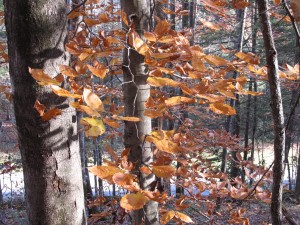Mighty as an oak pretty much describes American beech (Fagus grandifolia) as well. Enjoy all four seasons of American beech: spring/summer dark green leaves, dark tan colored fall foliage, long pointed winter buds, and bluish gray bark. It is a large 50-70 foot woodland tree and tolerates incredible amounts of shade.
Slow growing beeches are long-lived and best planted on large ground acreages such as golf courses, public parks, and corporate centers where future generations can enjoy them. Plant them in a well-drained, slightly acidic, loamy soil. Contrary to what’s written in many books, American beeches transplant easily either as container-grown or balled and burlapped (b&b) nursery stock.
Constructing a home inside a woodlands is usually destructive to the beech and oak (Quercus spp.) occupants. Beech roots are sensitive to being “stepped on” by heavy construction equipment or covered up with soil and debris. Also, don’t plan to grow a lawn because beech is shallow rooted and casts a dense foliage canopy. Its serrated edged leaves are 3-5 inches long and 1-2 inches wide, presenting an overall fine leaf textured appearance.
American beech is monoclonal while European beech (F. sylvatica) offers several cultivars. Beechnuts are an important fall/winter food source (called “mast”) for many wildlife species. In recent years a potentially serious beech bark disease complex has destroyed hundreds of acres of American beech across the U.S. Long summer dry periods have contributed to American beech losses.
Its gray colored bark has been a favorite of lovers who proclaim their everlasting love for one another by etching their initials into beech trunks. It would be healthier for beech if they went to courting with candy or flowers.


 Posted in
Posted in 
